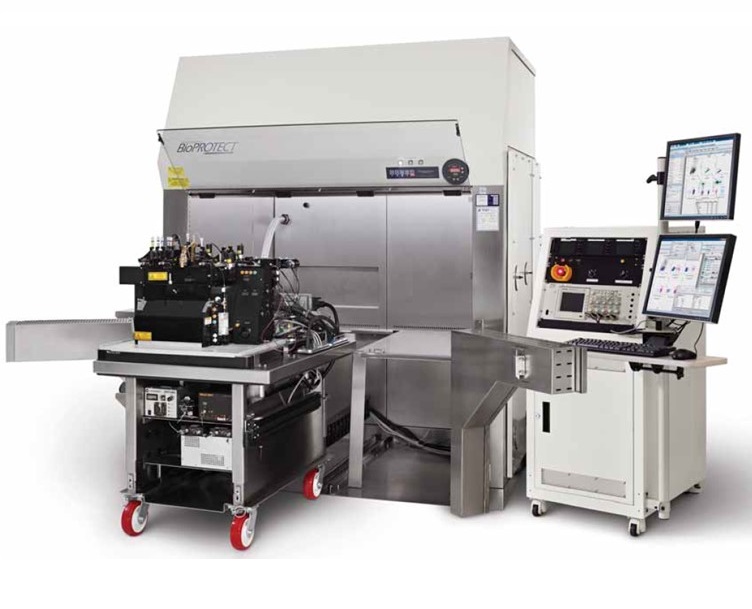The Cell Sorter Market involves instruments and technologies used to separate and sort cells based on their specific characteristics, such as size, morphology, protein expression, and other phenotypic markers. This process, known as cell sorting, is essential in various fields of research and clinical applications, such as cancer research, stem cell research, immunology, and diagnostics. Cell sorters are widely used in laboratories and research centers to isolate specific cell populations for further analysis or therapeutic use.
With advancements in biotechnology and molecular biology, the cell sorter market is growing, driven by an increasing demand for precision in cell-based research and therapies. The development of high-throughput and multi-parametric sorting capabilities has also contributed to market expansion.
Market Trends
- Increasing Adoption of Flow Cytometry-Based Sorters: Flow cytometry is one of the most popular technologies for cell sorting due to its ability to sort cells based on multiple parameters. The growing adoption of flow cytometry-based cell sorters in both research and clinical applications is driving market growth.
- Rising Demand in Cancer and Stem Cell Research: Cell sorting plays a critical role in isolating specific cancer cell types for research and therapeutic purposes. Similarly, in stem cell research, precise cell sorting is essential to isolate and expand stem cells for regenerative medicine applications. These fields are expected to drive demand for cell sorters significantly.
- Technological Advancements in Cell Sorting: Recent advancements in microfluidics, magnetic-activated cell sorting (MACS), and fluorescence-activated cell sorting (FACS) technologies have enhanced the accuracy, speed, and efficiency of cell sorting processes. These innovations are creating more opportunities for researchers to conduct high-throughput and precise sorting.
- Growing Interest in Single-Cell Genomics: Single-cell genomics and transcriptomics are becoming increasingly popular in research, particularly in the study of tumor heterogeneity, immunology, and neurobiology. Cell sorters enable researchers to isolate specific cell populations for downstream genomic analysis, further fueling market growth.
- Expansion of Cell Therapy and Regenerative Medicine: Cell-based therapies, such as CAR-T cell therapy, have gained significant traction in recent years. Precise sorting of immune cells is critical for developing such therapies, leading to higher demand for advanced cell sorters in clinical and research settings.
Market Dynamics
Drivers
- Growing Biomedical and Clinical Research: The increasing focus on biomedical research, particularly in areas like immunology, oncology, and stem cell research, is driving the demand for cell sorting technologies. These applications require precise isolation of specific cell populations, making cell sorters essential tools in laboratories.
- Rising Demand for Personalized Medicine: Personalized medicine relies on understanding individual cell populations, particularly in cancer treatment and immunotherapy. Cell sorting is crucial for identifying and isolating specific cells to develop targeted therapies, driving demand for advanced cell sorter technologies.
- Technological Advancements: Continuous advancements in cell sorting technologies, including improvements in speed, precision, and the ability to sort rare cell types, are expanding the market. Technologies such as microfluidics, automated systems, and next-generation flow cytometry are enhancing the overall capabilities of cell sorters.
- Expansion of Biopharmaceuticals: The growth of the biopharmaceutical industry, particularly in areas like biologics, gene therapy, and cell therapy, is driving demand for cell sorters to support drug discovery, development, and manufacturing processes.
Restraints
- High Cost of Equipment: Cell sorters are sophisticated and expensive pieces of equipment, which can be a barrier for small research laboratories and institutions with limited budgets. The high cost of maintaining and operating these devices can also be a restraint.
- Complexity of Operation: Cell sorters require skilled technicians for operation and maintenance. The complexity of these instruments can be a challenge for smaller labs or facilities with limited technical expertise.
- Regulatory and Ethical Issues: In clinical applications, cell sorting for therapies such as stem cell research and immunotherapy is subject to strict regulatory scrutiny and ethical concerns, which can delay approvals and limit market growth in certain regions.
Opportunities
- Emerging Markets: The increasing investment in biotechnology and healthcare infrastructure in emerging markets, particularly in Asia-Pacific and Latin America, presents significant growth opportunities for cell sorter manufacturers.
- Advances in Microfluidic and Nanotechnology: The integration of microfluidic and nanotechnology into cell sorting systems offers the potential for more efficient, high-throughput sorting processes. These advancements could lead to the development of smaller, more affordable cell sorters that are easier to operate and maintain.
- Expansion of Cell and Gene Therapy: The rapid growth of cell and gene therapies, particularly for treating cancer and genetic disorders, presents a significant opportunity for cell sorter manufacturers. These therapies rely heavily on the ability to sort and manipulate specific cell populations, increasing demand for advanced cell sorting technologies.
- AI and Automation: The incorporation of artificial intelligence (AI) and automation into cell sorting technologies has the potential to improve accuracy and throughput while reducing human error. Automated cell sorters could make the technology more accessible to a wider range of users.
Challenges
- Technical Limitations in Sorting Rare Cells: Sorting rare cell populations, such as circulating tumor cells, can be technically challenging. Improvements in sensitivity and accuracy are needed to address these limitations.
- Time-Consuming and Labor-Intensive Processes: Despite advances in automation, cell sorting can still be time-consuming and labor-intensive. Developing faster, more efficient systems is a key challenge for the market.
Click Here, To Get Free Sample Report https://stringentdatalytics.com/sample-request/cell-sorter-market/15211/
Market Segmentations
Global Cell Sorter Market: By Company
BD
Beckman Coulter
On-Chip Biotechnologies Co., Ltd.
Miltenyi Biotec GmbH
Sony Biotechnology
Sysmex Partec GmbH
Cytonome
Bio-Rad Laboratories
Affymetrix, Inc.
Union Biometrica, Inc.
Global Cell Sorter Market: By Type
High-Range Cell Sorters
Mid-Range Cell Sorters
Low-Range Cell Sorters
Global Cell Sorter Market: By Application
Hospital
Biotech & Pharmaceutical
Laboratory
Others
Global Cell Sorter Market: Regional Analysis
The regional analysis of the global Cell Sorter market provides insights into the market’s performance across different regions of the world. The analysis is based on recent and future trends and includes market forecast for the prediction period. The countries covered in the regional analysis of the Cell Sorter market report are as follows:
North America: The North America region includes the U.S., Canada, and Mexico. The U.S. is the largest market for Cold-chain Pharma in this region, followed by Canada and Mexico. The market growth in this region is primarily driven by the presence of key market players and the increasing demand for the product.
Europe: The Europe region includes Germany, France, U.K., Russia, Italy, Spain, Turkey, Netherlands, Switzerland, Belgium, and Rest of Europe. Germany is the largest market for Cold-chain Pharma in this region, followed by the U.K. and France. The market growth in this region is driven by the increasing demand for the product in the automotive and aerospace sectors.
Asia-Pacific: The Asia-Pacific region includes Singapore, Malaysia, Australia, Thailand, Indonesia, Philippines, China, Japan, India, South Korea, and Rest of Asia-Pacific. China is the largest market for Cold-chain Pharma in this region, followed by Japan and India. The market growth in this region is driven by the increasing adoption of the product in various end-use industries, such as automotive, aerospace, and construction.
Middle East and Africa: The Middle East and Africa region includes Saudi Arabia, U.A.E, South Africa, Egypt, Israel, and Rest of Middle East and Africa. The market growth in this region is driven by the increasing demand for the product in the aerospace and defense sectors.
South America: The South America region includes Argentina, Brazil, and Rest of South America. Brazil is the largest market for Cold-chain Pharma in this region, followed by Argentina. The market growth in this region is primarily driven by the increasing demand for the product in the automotive sector.
Click Here, To Buy Premium Report https://stringentdatalytics.com/purchase/cell-sorter-market/15211/?license=single
Key Points:
- Define, describe and forecast The Global Market by type, application, end user and region.
- Provide enterprise external environment analysis and PEST analysis.
- Provide strategies for company to deal with the impact of COVID-19.
- Provide market dynamic analysis, including market driving factors, market development constraints.
- Provide market entry strategy analysis for new players or players who are ready to enter the market, including market segment definition, client analysis, distribution model, product messaging and positioning, and price strategy analysis.
- Keep up with international market trends and provide analysis of the impact of the COVID-19 epidemic on major regions of the world.
- Analyze the market opportunities of stakeholders and provide market leaders with details of the competitive landscape.
About Stringent Datalytics
Stringent Datalytics offers both custom and syndicated market research reports. Custom market research reports are tailored to a specific client’s needs and requirements. These reports provide unique insights into a particular industry or market segment and can help businesses make informed decisions about their strategies and operations.
Syndicated market research reports, on the other hand, are pre-existing reports that are available for purchase by multiple clients. These reports are often produced on a regular basis, such as annually or quarterly, and cover a broad range of industries and market segments. Syndicated reports provide clients with insights into industry trends, market sizes, and competitive landscapes. By offering both custom and syndicated reports, Stringent Datalytics can provide clients with a range of market research solutions that can be customized to their specific needs.
Contact Us
Stringent Datalytics
Contact No- +1 346 666 6655
Email Id- sales@stringentdatalytics.com




Leave a Reply